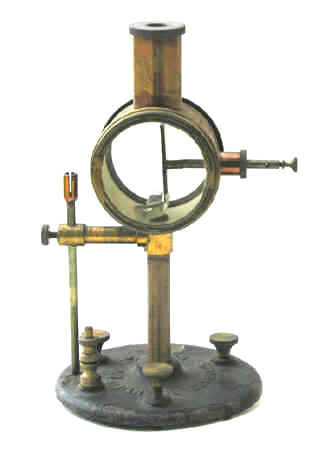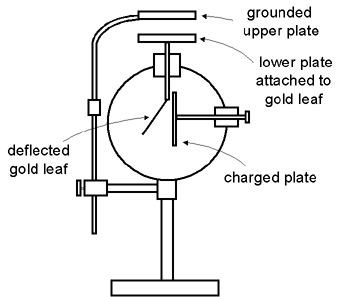Zeleny Electroscope (ca. 1920)
Designed in 1911 by John Zeleny, a physicist at the University of Minnesota, and primarily intended for classroom demonstrations. Nevertheless, it could be used for quantitative measurements of radiation and radioactivity.
Its main feature is a vertical metal plate connected to a horizontal rod. The latter penetrates the side of the electroscope’s cylindrical metal case and is used to both charge the plate and move it back and forth (the plate is reminiscent of the charged plate in CTR Wilson’s tilted electroscope). A single gold leaf is suspended from a rod that penetrates the top of the case. The rod, in turn, is connected to a horizontal brass disk—the latter is missing in the example shown here. Above and parallel to this disk is another disk (also missing) that is connected to the grounded case via the vertical arm (on left side). The space between the lower and upper disk can be considered an “ionization chamber.”


What is truly unique about the Zeleny electroscope is its mode of operation. The vertical plate is given a potential of approximately 100 volts relative to the grounded case. By means of the horizontal rod, the plate is brought into contact with the gold leaf. The charged leaf is repelled away from the plate. As the air between the two horizontal disks on top of the electroscope is ionized, the charge on the gold leaf is reduced and the leaf falls back towards the plate. When it comes in contact with the charged plate, the leaf is repelled and the process repeats itself. The frequency of these repeating “kicks” is used as the measure of the ionization.
When used to analyze radioactive material, the sample could be placed on the lower of the two disks. Of course, the electroscope was used in other ways as well. Alois Kovarik, a student of Zeleny’s and a onetime collaborator with Hans Geiger, used the Zeleny electroscope to register discharges from a point counter (an early version of what came to be the Geiger Mueller detector.
This electroscope came from the University of Minnesota where Zeleny worked. So it is quite possible that at one time this was Zeleny's Zeleny electroscope.
References
- John Zeleny. A Lecture Electroscope for Radioactivity. Physical Review. Vol. 32: 255-256. 1911.
- John Zeleny. A Lecture Electroscope for Radioactivity and other Ionization Experiments. Physical Review. Vol. 32: 581-584. 1911.
